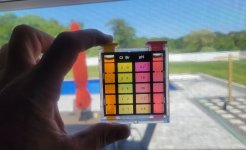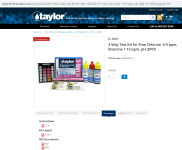- Aug 29, 2012
- 58
- Pool Size
- 22000
- Surface
- Plaster
- Chlorine
- Salt Water Generator
- SWG Type
- CircuPool RJ-45 Plus
I love my TF-100 test kit from tftestkits - I do. I love the accuracy and simplicity in instructions. I've also had (started with back 10 years ago) the Taylor K-2006.
I also loved my K-1000 for a quick and dirty pH and quick chlorine test until I got my salt water chlorine generator (SWCG). I would purposely keep my CLA low enough that my recommended chlorine level fell between ~2-4ppm so that I could use the quick and dirty test from the K-1000....and ESPECIALLY so that when I travelled for work, it was easy to show my wife/daughter/neighbor/friend how to test for chlorine really quickly and fairly painlessly.
It's also a cheap test and uses little in the way of reagents, so can be done more often. I don't need 0.5ppm accuracy every day like the chlorine drop test gives. That's great weekly or after an event (like a party or storms) but not every day or even every other day. I know my pool and can judge pretty well, but I still like to test and definitely want people watching the pool for me to test.
Why does the K-1000 that goes above 5ppm? That max range seems low, even for a lot of people without SWCG out in the real world. I can find a Taylor high range comparitor but can't find how to use it or what it uses....
Is there something out there that I don't know about? Maybe reasons why not? For me, with the SWCG I like to test even more often just to be sure it's working and nothing is going off track. When I used liquid chlorine I KNEW how much chlorine was added, with the SWCG I have a % level set but is it enough? Did something not work? Is all OK? I don't know unless I test.
Comparison for daily testing with recommended levels:
K-1000 test requires 5 drops of reagent. Done.
T-100 (and equivalent Taylor tests) is a scoop of FAS/DPD powder and at least 14 drops of R-0871 (to measure at least 7ppm free chlorine)
Why not have a quick kit that has a range of, say, 4-10ppm? One kit that has comparitor tubes for pH and chlorine with a chlorine range as I mentioned? What am I missing?
I also loved my K-1000 for a quick and dirty pH and quick chlorine test until I got my salt water chlorine generator (SWCG). I would purposely keep my CLA low enough that my recommended chlorine level fell between ~2-4ppm so that I could use the quick and dirty test from the K-1000....and ESPECIALLY so that when I travelled for work, it was easy to show my wife/daughter/neighbor/friend how to test for chlorine really quickly and fairly painlessly.
It's also a cheap test and uses little in the way of reagents, so can be done more often. I don't need 0.5ppm accuracy every day like the chlorine drop test gives. That's great weekly or after an event (like a party or storms) but not every day or even every other day. I know my pool and can judge pretty well, but I still like to test and definitely want people watching the pool for me to test.
Why does the K-1000 that goes above 5ppm? That max range seems low, even for a lot of people without SWCG out in the real world. I can find a Taylor high range comparitor but can't find how to use it or what it uses....
Is there something out there that I don't know about? Maybe reasons why not? For me, with the SWCG I like to test even more often just to be sure it's working and nothing is going off track. When I used liquid chlorine I KNEW how much chlorine was added, with the SWCG I have a % level set but is it enough? Did something not work? Is all OK? I don't know unless I test.
Comparison for daily testing with recommended levels:
K-1000 test requires 5 drops of reagent. Done.
T-100 (and equivalent Taylor tests) is a scoop of FAS/DPD powder and at least 14 drops of R-0871 (to measure at least 7ppm free chlorine)
Why not have a quick kit that has a range of, say, 4-10ppm? One kit that has comparitor tubes for pH and chlorine with a chlorine range as I mentioned? What am I missing?
Last edited:



